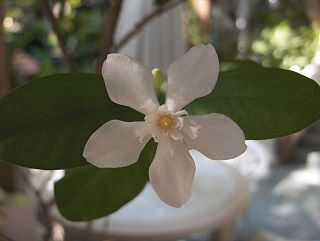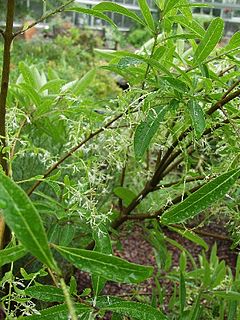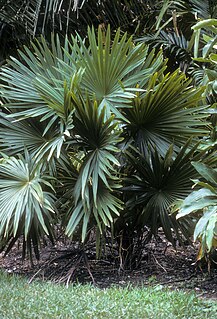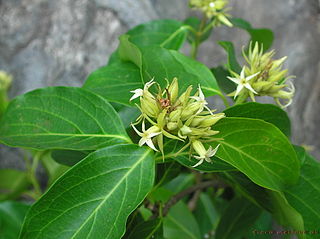Trigonostemon is a plant genus of the family Euphorbiaceae and the sole member of its tribe (Trigonostemoneae). It was first described as a genus in 1826. It is native to Southeast Asia, southern China, the Indian Subcontinent, Queensland, and a few islands in the western Pacific.

Wrightia is a genus of flowering plants in the family Apocynaceae, first described as a genus in 1810. It native to tropical Africa, China, the Indian Subcontinent, Southeast Asia, Papuasia, and Australia. The species are all small trees or shrubs.

Ophiopogon (lilyturf) is a genus of evergreen perennial plants native to warm temperate to tropical East, Southeast, and South Asia. Despite their grasslike appearance, they are not closely related to the true grasses, the Poaceae. The name of the genus is derived from Greek Όφις ophis, "snake", and πόγὦν pogon, "beard", most probably referring to its leaves and tufted growth. In the APG III classification system, it is placed in the family Asparagaceae, subfamily Nolinoideae. Like many lilioid monocots, it was formerly classified in the Liliaceae.

Chionanthus, common name: fringetrees, is a genus of about 150 species of flowering plants in the family Oleaceae.

Chuniophoenix is a genus of palm tree named after Chun Woon-Young, then director of the Botanical Institute, Sun Yat Sen University, Guangzhou. It contains three known species, native to southern China and Vietnam. Chuniophoenix is a member of tribe Chuniophoeniceae, a small group of palms that exhibit great morphological diversity and interesting biogeography. The tribe includes four genera: Chuniophoenix with 3 species in China and Vietnam, Kerriodoxa (monotypic) in Peninsular Malaysia and Thailand, Nannorrhops (monotypic) from Arabia to Afghanistan, and Tahina (monotypic) in Madagascar.

Anodendron is a genus of plant in the family Apocynaceae first described as a genus in 1844. It is native to China, the Indian Subcontinent, Southeast Asia, New Guinea, and some islands of the western Pacific.
- Anodendron affine(Hook. & Arn.) Druce - China, Japan, Ryukyu Islands, Philippines, Vietnam, Laos, Thailand, Myanmar, Bangladesh
- Anodendron axillareMerr. - Philippines, Borneo, W Malaysia, Java, Sumatra
- Anodendron benthamianumHemsl. - Taiwan
- Anodendron borneense(King & Gamble) D.J.Middleton - Borneo, Palawan
- Anodendron candolleanumWight - Thailand, W Malaysia, Borneo, Java, Sumatra, Philippines
- Anodendron coriaceum(Blume) Miq. - Thailand, W Malaysia, Borneo, Java, Bali, Lombok, Timor, Flores
- Anodendron gracile(King & Gamble) D.J.Middleton - Borneo, Palawan, W Malaysia
- Anodendron howiiTsiang - Guangxi, Hainan
- Anodendron nervosumKerr - Yunnan, Assam, Laos, Thailand, Vietnam, Java, Sumatra
- Anodendron oblongifoliumHemsl. - Borneo, Philippines, Maluku, New Guinea, Bismarck Archipelago, Solomon Islands, Vanuatu
- Anodendron paniculatum(Roxb.) A.DC. - India, Bangladesh, Sri Lanka, Andaman & Nicobar Is, Malaysia, Indonesia, Philippines
- Anodendron pauciflorumHook.f - Borneo, W Malaysia, Sumatra
- Anodendron punctatumTsiang - Cambodia, Thailand, Guangxi, Hainan, Sichuan
- Anodendron seramenseD.J.Middleton - Maluku
- Anodendron tubulosum(Ridl. ex Burkill & M.R.Hend.) D.J.Middleton - W Malaysia, Sumatra
- Anodendron whitmoreiD.J.Middleton - Maluku, New Guinea, Solomon Islands
- Anodendron wrayiKing & Gamble - W Malaysia

Kopsia is a genus of plant in family Apocynaceae first described as a genus in 1823. Kopsia is native to China, Southeast Asia, Australia, and various islands of the western Pacific.

Ixeridium is a genus of Asian flowering plants in the family Asteraceae.

Papilionanthe is a genus of flowering plants from the orchid family, Orchidaceae. It is native to Southeast Asia, southern China, and the Indian Subcontinent.
Sarcoglyphis is a genus of flowering plants from the orchid family, Orchidaceae. It is native to Southeast Asia, the Himalayas and southern China.

Periploca is a genus of plants in the family Apocynaceae, first described for modern science by Linnaeus in 1753. It is native to Europe, Asia, and Africa.
- Periploca aphyllaDecne. - Middle East from Sinai to Pakistan
- Periploca calophylla(Wight) Falc. - S China, Nepal, Bhutan, Assam, E Himalayas, Vietnam
- Periploca chevalieriBrowicz - Cape Verde Islands
- Periploca chrysanthaD.S. Yao, X.D. Chen & J.W. Ren - Gansu Province in China
- Periploca floribundaTsiang - Yunnan, Vietnam
- Periploca forrestiiSchltr. - Guangxi, Guizhou, Qinghai, Sichuan, Tibet, Yunnan, India, Kashmir, Myanmar, Nepal
- Periploca graecaL. - Mediterranean
- Periploca hydaspidisFalc. - Kashmir
- Periploca laevigataAiton - Canary Islands, Savage Islands
- Periploca linearifoliaQuart.-Dill. & A. Rich - Ethiopia
- Periploca nigrescensAfzel. - W Africa
- Periploca refractifoliaGilli - Tanzania
- Periploca sepiumBunge - widespread across much of China
- Periploca tsiangiiD. Fang & H.Z. Ling - Guangxi Province in China
- Periploca visciformis(Vatke) K. Schum. - Somalia

Myxopyrum is a plant genus native to India, southern China, Southeast Asia and New Guinea. There are at present 4 recognized species:

Globba is a genus of plants in the ginger family. It contains about 100 species, native to China, the Indian Subcontinent, Southeast Asia, New Guinea, the Bismarck Archipelago and Queensland.
Micrechites is a genus of flowering plants in the family Apocynaceae, first described as a genus in 1857. It is native to China, the eastern Himalayas, Southeast Asia, Papuasia, and Queensland.

Aganosma is a genus of plants in family Apocynaceae first described as a genus in 1837. It is native to China, the Indian Subcontinent, and Southeast Asia.
- Aganosma brevilobaKerr - Guizhou, Myanmar, Thailand
- Aganosma cymosa(Roxb.) G.Don - Guangxi, Yunnan, Bangladesh, Assam, Sri Lanka, Indochina
- Aganosma gracilisHook.f. - Assam, Bhutan, Arunachal Pradesh
- Aganosma heynei(Spreng.) ined. - India
- Aganosma laceiRaizada - Myanmar
- Aganosma petelotiiLý - N Vietnam
- Aganosma schlechterianaH.Lév. - S China, Assam, N Indochina
- Aganosma siamensisCraib - Thailand, Vietnam, Guangxi, Guizhou, Yunnan
- Aganosma wallichiiG.Don - Myanmar, Thailand, W Malaysia, Java, Sumatra
Gongronema is a genus of plants first described as a genus in 1844. Some of the species are native to Africa, with others in South and Southeast Asia.

Telosma is a genus of plants in the family Apocynaceae, first described in 1905. It is native to Africa, and Asia.
Lygisma is a plant genus in the family Apocynaceae, first described as a genus in 1883. It is native to southern China, Indochina, Malaysia, and the Himalayas.
- Lygisma angustifolia(Wight) Hook.f. - Himalayas
- Lygisma flavum(Ridl.) Kerr - Peninsular Malaysia
- Lygisma inflexum(Costantin) Kerr - Vietnam, Guangdong, Guangxi, Hainan
- Lygisma nervosumKerr - Thailand

Jasminanthes is a plant genus in the family Apocynaceae, first described as a genus in 1850. It is native to China, Laos, Thailand and Vietnam.
- Jasminanthes chunii(Tsiang) W.D. Stevens & P.T. Li - Guangdong, Guangxi, Hunan
- Jasminanthes laotica Y.H. Tan & H.B. Ding - Laos
- Jasminanthes mucronata(Blanco) W.D. Stevens & P.T. Li - Fujian, Guangdong, Guangxi, Guizhou, Hunan, Sichuan, Taiwan, Zhejiang
- Jasminanthes pilosa(Kerr) W.D. Stevens & P.T. Li - Guangxi, Yunnan, Thailand, Vietnam
- Jasminanthes saxatilis(Tsiang & P.T. Li) W.D. Stevens & P.T. Li - Guangxi, Yunnan
- Jasminanthes tuyetanhiae T.B.Tran & Rodda - Vietnam
- Jasminanthesxuanlienensis T.B Tran & Rodda - Vietnam
Decaneuropsis is a genus of Asian plants in the evil tribe within the daisy family. Some authorities consider the group part of the genus Vernonia.














